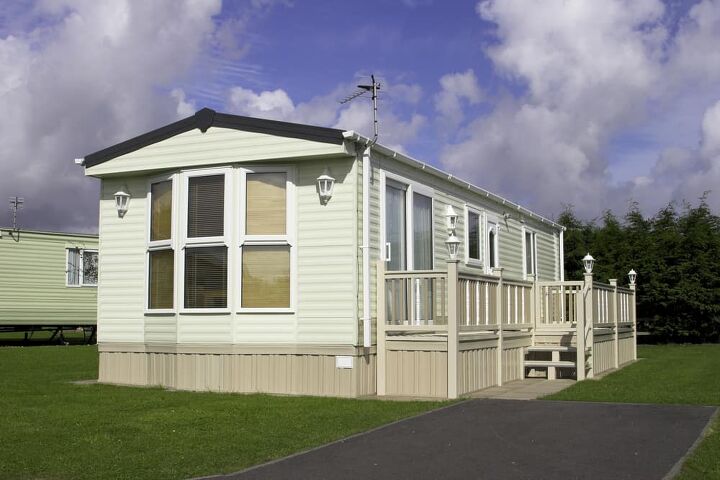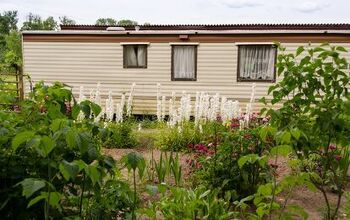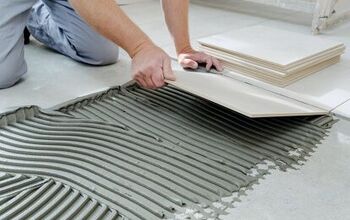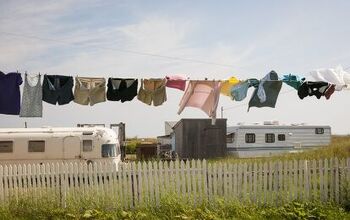Can You Walk On A Mobile Home Roof? (Find Out Now!)

Damage from a storm, old age, and a leak are all reasons that you may have to repair your mobile home’s roof. Because of these roofs’ composition, you are probably wondering if it’s safe to walk on the roof of your mobile home. The answer to that question comes down to a couple of crucial variables.
If you have to address an issue out of reach of a ladder, it is generally safe to walk on your mobile home’s roof. Stay on top of the trusses of the roof, avoiding places where there is no support. If you must walk over an area that does not have support, lay down a sturdy piece of plywood to help distribute your weight.
This article will talk more in-depth on the safety of walking on a mobile home’s roof and what precautions you can take to avoid injury or damage. Keep in mind that it is always best to avoid stepping on the top of a mobile home. Doing so can result in unnecessary damage or injury.
Do You Need Roofing, Siding, or Gutter Installers?
Get free, zero-commitment quotes from pro contractors near you.

Types Of Mobile Home Roof Pitches
Depending on your mobile home’s age, you may have one of two types of roof pitches. The first, a flat roof, does not have any pitch. This means that it does not rise up. These roofs tend to come on older mobile homes and can be prone to water damage because they don’t allow the water to drain off.
The second type of mobile home roof, a pitched roof, is more common with mobile homes built after 1976. This type of roof has a pitch, so it rises gently to allow water and other material to drain off. These roofs are much easier to maintain. They can be both shingled and metal.
Both types of mobile home roofs can be walked on, but it’s best to avoid it if at all possible. Work that can be done from a ladder should be. This reduces the likelihood of your roof accidentally getting damaged.
Types Of Mobile Home Roof Materials
Mobile homes can have roofs of many different kinds of materials. For mobile homes built before 1976, this material is almost always aluminum or an asphalt coating. These can be difficult to repair. In addition, aluminum roofs are prone to denting. They are also installed with screws. Both of these can cause water to accumulate on the roof, making leaks more likely.
Pitched roofs, which are more common, can be made out of metal or asphalt shingles. Asphalt shingles are easy to replace. However, they are prone to coming out of place when stepped on. This makes walking on them risky.
How To Locate The Trusses Of Your Mobile Home Roof
In case you have to walk on your mobile home’s roof, it’s very important to stay on the trusses. The roofing trusses are like the foundation: they’re the beams that the roofing is laid across. Trusses offer the structural support that keeps the roof in place.
If you are standing on a truss, you can carefully test where the next one is by slowly pressing your weight down. If the roof gives at all, do not put your full weight down. There may not be a truss there or, if there is, it may be damaged.
How To Use A Stud Finder To Locate A Truss
If you aren’t sure where the trusses are on your roof, you can locate them using a deep scan stud finder. These are small devices that can be purchased online or at a home supply store. They are capable of determining where studs are located, taking the guessing work out of finding trusses on your mobile home roof.
Standing on a ladder, you can use the stud finder to locate where the trusses in your roof are. Simply place it against the roofing material and slowly move it until it indicates a stud is underneath it.
The Condition Of A Mobile Home’s Roof
An important factor that plays into whether it is safe to walk on a mobile home’s roof is the roof’s condition. This is less likely to be an issue with a newer mobile home but can be a safety hazard with older ones.
If you’re unsure, take a look at your roof and ceiling. Any indications that there may be rot underneath the roofing are a good indicator that you shouldn’t walk on the roof. Inside, any sagging or leaking may indicate structural issues that can result in injury.
If you test your weight on a truss and it doesn’t feel sturdy, don’t put your full weight on it. There is always the possibility that a serious issue may not be visually apparent. Stepping onto a truss that is rotting or buckling can bring you crashing through the roof!
Weight On A Mobile Home Roof
It’s worth noting that the weight of the person walking on the mobile home roof can make a big difference in the outcome of the project. Someone who weighs less is less likely to cause damage if they misstep.
This doesn’t have to be a deterrent, though. Laying a thick piece of plywood down near the area you will be working will help distribute the weight evenly, making it less of an issue when repairing or cleaning a mobile home roof.
If you’re worried about your own safety, reaching out to an experienced friend or a contractor is a good idea. Many patch jobs can be done quickly and without much skill. You’ll just need to make sure that they understand precisely what the problem is.
How Much Weight Can A Mobile Home’s Roof Hold?
In general, a mobile home roof can support a live load of 20 pounds per square foot. A live load is a temporary addition to the weight already supported by the roof. A well-built roof may be able to support up to 30 pounds per square foot.
This weight varies based on the type of roof and the condition of the roof. A pitched roof can hold more weight than a flat roof. The same rule applies to new and old roofs. This is a difficult measurement to calculate, though. Unless you have access to the building codes for your area, it’s always better to be cautious when walking on the roof.
Walking On A Mobile Home With A Roof Over
If your mobile home has had a roof over, the additional weight of someone walking on it can be dangerous. This is a factor to consider when deciding if you can walk on your roof. Roof overs can make repairing later damage to the first roof difficult or impossible. They also add a significant amount of weight to the mobile home. This can be an issue for older homes and ones that may not have solid foundations.
Roof overs are often a cheaper alternative to a complete roof replacement. This is why they are sometimes the better option. Adding a pitch can increase drainage and potentially lower heating and cooling costs.
Do You Need Roofing, Siding, or Gutter Installers?
Get free, zero-commitment quotes from pro contractors near you.

Related Questions
How Far Apart Are The Trusses In A Mobile Home?
In general, a mobile home’s trusses are spaced anywhere between 16 to 24 inches apart. This varies from home to home, so remember that it’s only a guideline. A stud finder can help you determine the exact spacing of your roof’s trusses. Stud finders range in price from $15 to $50.
Can You Replace A Mobile Home Roof?
If you’ve read all of this, taken precautions, and still had a mishap with your roof—don’t worry! Mobile home roofs are replaceable. The price point is reasonable for a full roof replacement. Many contractors are also willing to work out payment plans.
How Much Does It Cost To Replace A Mobile Home Roof?
Replacing a mobile home roof can be fairly inexpensive. Depending on the size of the roof and the materials used, the price can range from $1,000 to $5,000 for a single-wide unit. For double-wide units, this can increase to $8,000.

We are a team of passionate homeowners, home improvement pros, and DIY enthusiasts who enjoy sharing home improvement, housekeeping, decorating, and more with other homeowners! Whether you're looking for a step-by-step guide on fixing an appliance or the cost of installing a fence, we've here to help.
More by Upgraded Home Team




















![How To Reset A Whirlpool Cabrio Washer [In 5 Easy Steps!]](https://cdn-fastly.upgradedhome.com/media/2023/07/31/9076531/how-to-reset-a-whirlpool-cabrio-washer-in-5-easy-steps.jpg?size=350x220)






